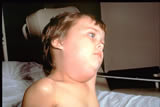The Disease.
Mumps is a contagious, notifiable disease caused by the Mumps virus, a member of the Paramyxoviridae family.
It is spread from person to person by saliva and primarily affects children.
Incubation period
Generally, incubation is 2-3 weeks, but may extend for 25 days. Infected people are communicable in the week prior to and the week following parotitis (salivary gland inflammation.)
Features
The infection causes fever and painful swollen salivary glands, but 20% of cases, especially in young children, have no symptoms.
When affected by mumps, 1 in 200 children develops encephalitis (brain inflammation). About one third of post-pubertal males develops inflammation of the testicles and some become infertile. A similar group of females will develop oophoritis. Occasionally, mumps causes deafness or pancreatitis.
Management
CDC recommends isolation for a period of five days from the onset of parotitis.
Exclude from school for 9 days or until swelling disappears.
In Victoria, mumps is a Group B notification and must be reported within 5 days.
In Australia, 10 deaths attributable to mumps were reported between 1978 and 1997. In 2000, 2 adults (both aged over 80 years of age) died from mumps.
A valuable and current resource on mumps is provided at the CDC site.
Australia
Between 1 July and 30 September 2006, there were 90 notifications of mumps – nearly three times the five year average. People aged between 25 and 34 were most at risk and all travellers in this age cohort should seek adequate immunisation.
The International Scene
The serious outbreaks of an easily prevented disease illustrates the potential for harm which is the consequence of ill-informed and emotional misinformation pedaled by anti-vaccine groups.
Many cases were reported during 2004-6 from the UK and Ireland, especially in young adults aged between 15 and 24 – >70,000 notified cases were reported in England and Wales.
This has prompted calls for the adequate vaccination, by MMR vaccine, of young adults visiting the area.
Hundreds of thousands of children have been affected in Denmark, Sweden, Finland and in the United States.
2006
The first major outbreak in more than 20 years occurred the first four months of 2006, when an unexpected epidemic started in the US state of Iowa and spread to neighbouring states in the Midwest producing some 2500 documented cases, 25 requiring hospitalisation. This compares with the usual 300 cases reported each year.
Most cases have occurred among persons 18-25 years of age, many of whom have been vaccinated. A mass vaccination program commenced at the end of April.
In June, another outbreak was reported from the Boston area.
2008
Europe
Between 1 October 2007 and 2 March 2008, a total of 14,729 mumps cases were notified in the Republic of Moldova. These cases occurred mainly in those having only one or no vaccinations.
Ireland reported 400 cases in 2008.
Canada
400 cases have been reported from southern Alberta; others in British Columbia.
2009
The UK remains the basket case of western nations when it comes to mumps vaccination, with 250 verified cases in the first three months of the year.
Vaccine Information.
In Australia, the available mumps vaccine is a trivalent live attenuated combination vaccine, Priorix, from GlaxoSmithKline which also contains rubella and measles vaccines.
(MMR II has been withdrawn from the Australian market.) (see also measles)
Side effects:
About 10% of vaccine recipients have discomfort, local inflammation or fever. Of those children receiving the vaccine, about 1% develop a noninfectious rash, about 1% develop parotid gland swelling and febrile convulsions occur in 0.1%. No vaccine recipients develop encephalitis (inflammation of the brain).
Travellers, especially to Asia, should be vaccinated (see above).
Contradindications
Measles, mumps, rubella and varicella vaccines are contraindicated in
– people with impaired immunity (eg due to HIV/AIDs, high dose steroids, immunosuppressive treatment and certain malignancies),
– people having had a previous anaphylaxis reaction to a vaccine or component of a vaccine,
– pregnancy should be avoided for 28 days.
Uncertain about MMR? The NCIRS Decision Aid should help.
The future
In the near future, a quadrivalent vaccine from Merck/CSL containing vaccines which protect against measles, mumps, rubella and varicella (ProQuad) has recently been approved in the US and in Australia.
Vaccine effectiveness
The effectiveness of Priorix against mumps is about 80% after one dose and 90% after two doses. For these reasons, and considering the fairly long incubation period, some vaccinated people will acquire the disease.
History
An account of significant events in measles, mumps and rubella immunisation practice in Australia is available at the NCIRS site.

